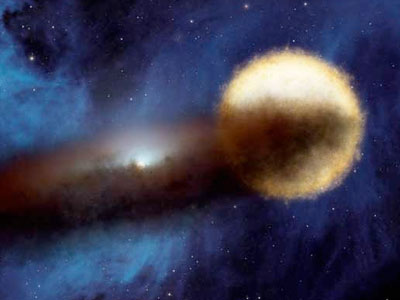The International Space Station (ISS) is participating in a significant astronomical observation program just getting underway, followed by thousands of amateur and professional astronomers: the Epsilon Aurigae Eclipse.
A specific star in the constellation Auriga (Charioteer) called Epsilon Aurigae undergoes an eclipse (being occulted) every 27.1 years. This has puzzled astronomers for nearly 200 years.
The eclipse lasts nearly two years which, with the 27.1 year period, means the eclipsing body must be gigantic.

Artist's concept of Epsilon Aurigae. Credit: NASA/JPL-CaltechThere may be a temporary brightening at mid-eclipse. There have been no satisfactory explanations to date for this. Is it a giant cloud of gas with a doughnut-like hole, permitting the star to brighten during mid-eclipse?
The Sun's proximity to Epsilon Aurigae, as seen from the ground, prevents observations by ground-based astronomers during mid-eclipse, but astronauts on the ISS, having a different aspect angle, can observe and note changes in relative brightness, as suggested by the AAVSO (American Association of Variable Star Observers) following a talk by NASA Astronaut John Grunsfeld.
The method used by the crew is to compare the brightness of Epsilon Aurigae weekly with three other nearby stars of known and unchanging brightness.
Currently, at the northern portion of each orbit the crew has about a 25 minute window to view the star.












